I was more than ready to depart Doña Mare’s casa, with its outdoor stench and cramped interior into which the smell of cigarette smoke from an adjacent room pervaded. Since my ride was not to arrive until early afternoon, I decided to walk around the town a bit –– avoiding the nearby public school. I came across a warehouse size bodega and observed the patient patrons and paucity of products.
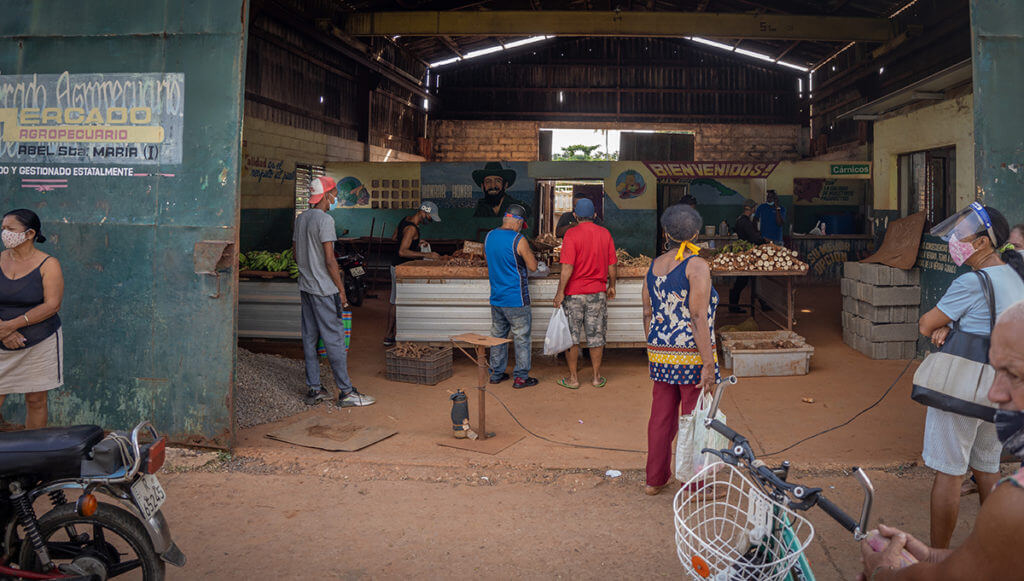 With me, I brought a bag with some of the last items I would donate, including a two-pound bag of brown rice, an unopened jar of peanut butter, and peanut brittle candies B had gifted to me upon returning from her most recent trip to Brazil earlier in the year. Little boys I came across playing in the streets received the latter, much to their delight; and a pair of elderly Black women sequentially received the rice and peanut butter. “It’s a Christmas present,” I said to them, and each of them thanked me with a blessing. One of the most reprehensible aspects of this world is, if you want to find the most marginalized, simply look at the darkness of the complexion; that, and the condition of their clothes was how I determined to whom I donated.
With me, I brought a bag with some of the last items I would donate, including a two-pound bag of brown rice, an unopened jar of peanut butter, and peanut brittle candies B had gifted to me upon returning from her most recent trip to Brazil earlier in the year. Little boys I came across playing in the streets received the latter, much to their delight; and a pair of elderly Black women sequentially received the rice and peanut butter. “It’s a Christmas present,” I said to them, and each of them thanked me with a blessing. One of the most reprehensible aspects of this world is, if you want to find the most marginalized, simply look at the darkness of the complexion; that, and the condition of their clothes was how I determined to whom I donated.
I walked some two kilometers to all the sides of the southern end of the town, seeking out the any improvised shacks, but nearly everyone was living in deteriorated apartment buildings – what we used to call “the projects” when I was a kid in New York City. I retained a bag of medicines until I could figure out a likely recipient.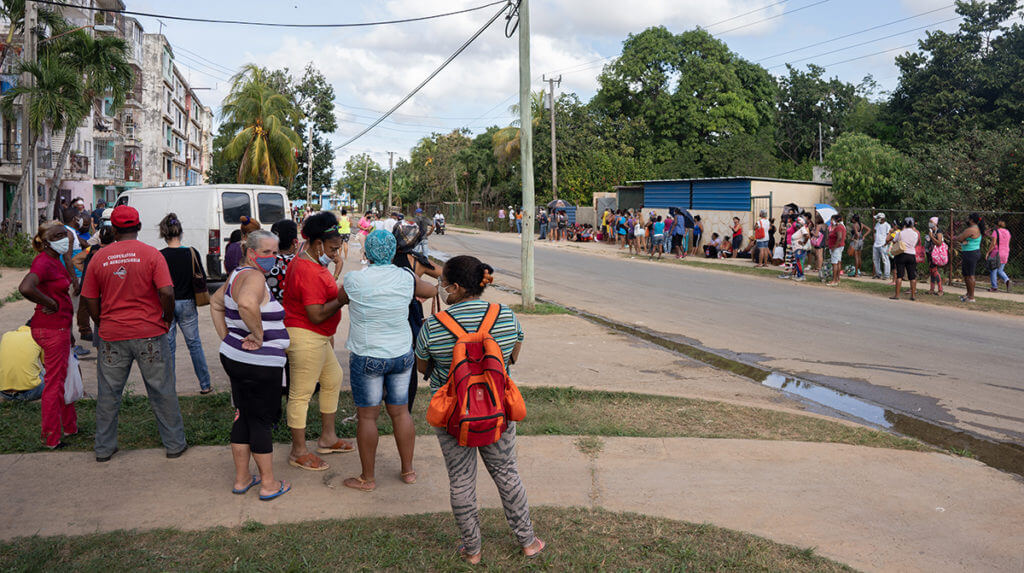
I also paused on one street in order to try to comprehend the sixty or so people lined up on all sides. I went and stood next to a man and chatted him up, asking what was going on – even though I pretty much could guess. He said, “Piccadillo,” minced cow meat. I asked with incredulity if all these people were waiting to buy from the single tiny storefront. He confirmed this and I learned they would have to wait “Hours – perhaps four or five hours” to enter and buy, according to their ration cards. People were spread out along the streets in an attempt to evade the sun – trending brutal at 11:00 a.m.
Upon my departure, Doña Mare seemed piqued that I didn’t have anything more to give her, and pointedly suggested that I do so with anything possible. I had already given her Black maid a small bag of beans and some candies, and I had earlier agreed to exchange 50 Euros with Doña Mare for Cuban pesos at a favorable rate. All I had left to gift, excluding the medicines, was a small bottle of Heinz catsup and some cookies. I was disappointed to find out that she had let the dog, Mocho, stay in his harness in the back yard until he had chewed through the leash. I resolved to find a pet supply store somewhere in Havana and have a proper harness be brought to the family in hopes they would continue to walk him regularly.
• • •
Humberto returned in his battered 1954 Wilson truck, which has a rear bed fitted with two benches capable of holding many passengers. We passed a number of people on the streets who tried to flag us down, but he did not stop – nor did any of my drivers on any of my trips. I would always say it was fine to stop to pick up needy riders, but the replies were along the line of me being the “booked passenger” preventing such additions. I thought this was both ludicrous and unfortunate, and always wondered how many hours the needy riders must wait for relief.
Once back in my Havana casa I dropped my bags – except for two cameras – and walked in the direction of the fancy restaurant I had found a few days earlier. After about five blocks, I noticed an elaborate Revolutionary Cuba wall mural just on the inside of one large building, and inquired to a man seated just inside, an imposing guard, if I could take some photos of the wall. Fidel and an excerpt of one of his speeches were the focus of the artwork. I then discovered that on the third floor there was a restaurant, and walked up the stairs of the decaying but once majestic building.
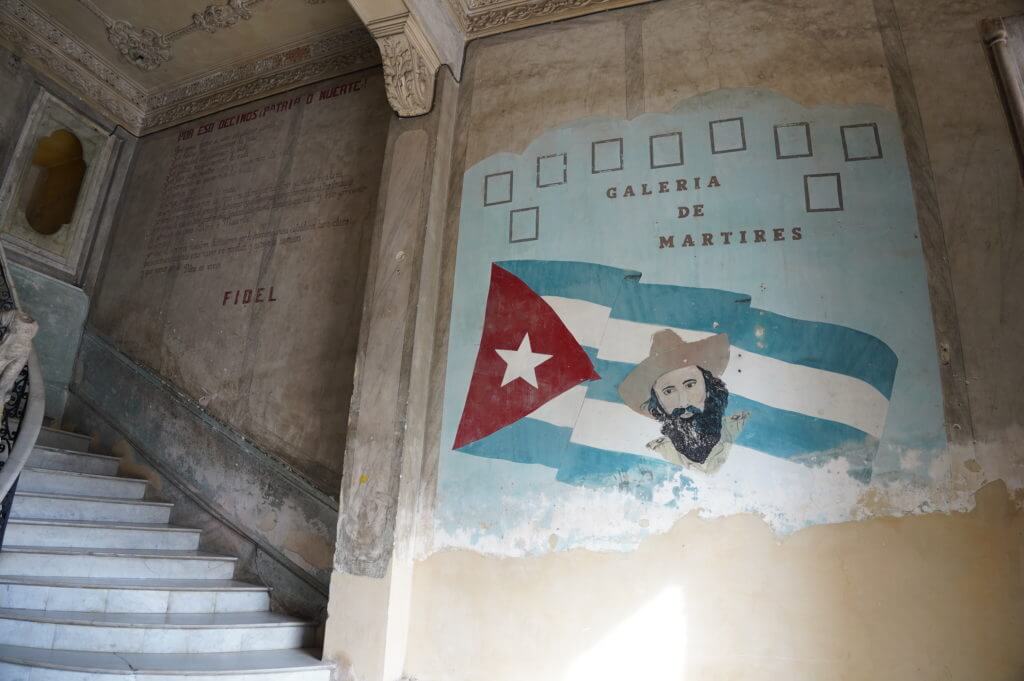
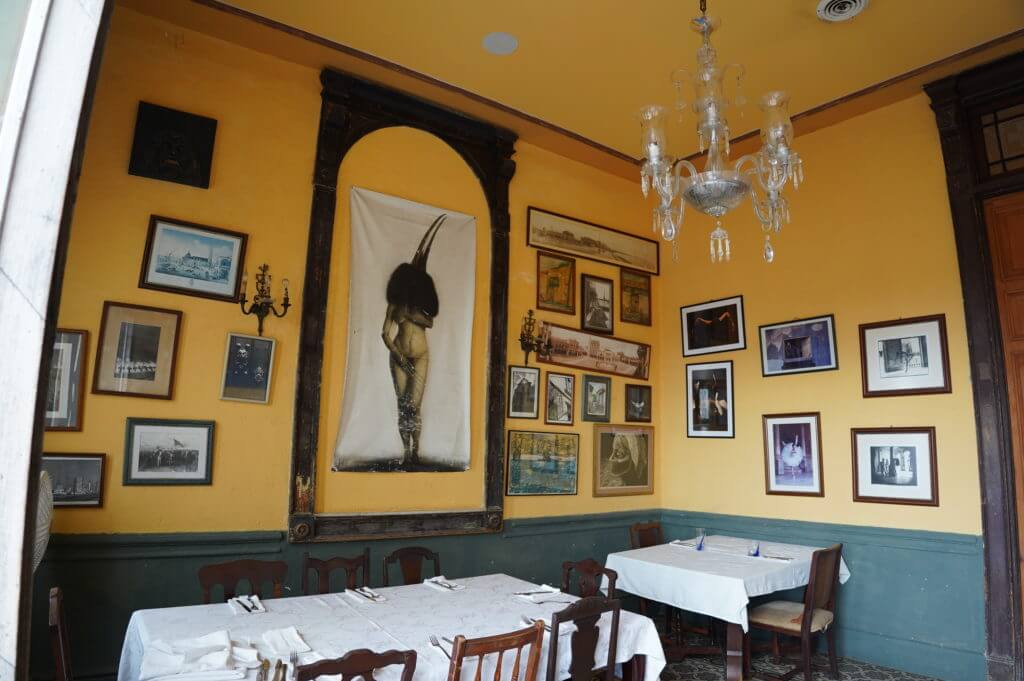 I found the restaurant to be another five-star affair. Each of the six rooms had dozens of photos or framed artworks. There were no printed menus; instead one must tune into the in-house wi-fi network and scan a digital square. I decided to have my lunch here, which would satisfy both my curiosity and hunger; I chose the “fungi risotto,” and a side dish of thinly sliced and lightly salted plantain, both of which arrived some 45 minutes later and were quite delicious. There was also 7-Up to drink, and I read the side of the can to find it was imported from Mexico. During the remainder of my stay in Cuba, I confirmed to my amazement that, tucked away in all parts of “Habana Vieja” were many such quality restaurants. They apparently had sources for all sorts of foodstuffs impossible for the average or poorer Cubans to obtain. The incongruity of these restaurants’ placement within the most wretched neighborhoods did not seem to prevent any conflict or concern to locals, but when I entered the first of these restaurants, I felt terrible to walk by lounging Cubans who appeared desperately impoverished, and I was glad I had packed my own food for most of my time in Cuba.
I found the restaurant to be another five-star affair. Each of the six rooms had dozens of photos or framed artworks. There were no printed menus; instead one must tune into the in-house wi-fi network and scan a digital square. I decided to have my lunch here, which would satisfy both my curiosity and hunger; I chose the “fungi risotto,” and a side dish of thinly sliced and lightly salted plantain, both of which arrived some 45 minutes later and were quite delicious. There was also 7-Up to drink, and I read the side of the can to find it was imported from Mexico. During the remainder of my stay in Cuba, I confirmed to my amazement that, tucked away in all parts of “Habana Vieja” were many such quality restaurants. They apparently had sources for all sorts of foodstuffs impossible for the average or poorer Cubans to obtain. The incongruity of these restaurants’ placement within the most wretched neighborhoods did not seem to prevent any conflict or concern to locals, but when I entered the first of these restaurants, I felt terrible to walk by lounging Cubans who appeared desperately impoverished, and I was glad I had packed my own food for most of my time in Cuba. 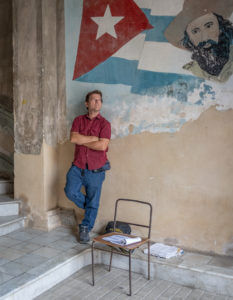 Upon departing the restaurant, I asked the guard if he would take some photos of me using one of my cameras in front of the Fidel mural, and returned, hunger sated, to the casa.
Upon departing the restaurant, I asked the guard if he would take some photos of me using one of my cameras in front of the Fidel mural, and returned, hunger sated, to the casa.
The next day, I had a conversation over breakfast with two of the women-owners about a range of topics that piqued my curiosity. I started off with pedestrian questions – shopping options and the like – but I was leading up to the most sensitive: what had they seen and understood about the July 11 anti-government demonstrations. I didn’t have the presence to record their responses, but I quickly returned to my room and amended an earlier section of this account, which dealt with the manifestaciónes. I had previously thought the claims of demonstrator vandalism was dubious, but when I later watched some clips on YouTube, I realized that it was not the demonstrators who were offensive, but rather locals – in a few Cuban cities – that took advantage of the two days of anger to loot and destroy. The few demonstrators who resisted the heavy-handed police response to huge numbers of fed-up citizens were, to me, entirely within their rights as long-suffering humans.
I had arranged for Franky, the 50-year-old son of one of the woman owners, to bicycle me to one of the few stores that accepted foreign currency and was said to have many items unobtainable by the average Cuban. I discovered as we were en route that, the day being a Sunday, the stores closed early. Indeed the streets were all pretty much empty. I asked Frankie to take me to La Plaza de la Revolución, one of the scores of locations across Havana that was a locus for angry protests on July 11-12, 2021. While he was slowly pedaling, I asked him for recollections of the days of rage. He said he did not see any vandalism in the streets near his home, but recounted hearsay accounts. He said at one point, “It is the women who are so angry and who were so strong in the demonstrations!” I said it was understandable, as women are in the majority queuing up for hours each day, who must tend to the men and care for the children (I didn’t add that it is they who must also endure daily harassment in the streets). I repeated what I had said to the two women-owners of my Havana casa, the Cubans must be fed-up with their daily misery. Franky became very sad and said he didn’t know how much longer he could put up with life as it is, then referred to some New Testament parable for inspiration. When Franky and I arrived to the Plaza, I asked him how much I owed for the trip. He sighed wearily and said “Diez pesos. O diez dolares.” It was a huge variance but I could understand his need –– and decided he deserved much more.
The Plaza of the Revolution in Havana is a sprawling design, incorporating many tall buildings housing ministries of one sort or another, with a 23-story tower and monument to José Martí in the center. I arrived around 2:00 p.m., finding the sun directly in my face and behind the central monuments; not the ideal lighting situation. I walked across a huge, virtually empty parking lot to the central monuments in order to take some photos from the other side. I noticed a guard by a wall watching me from a distance, and thought it strange that there were no tourists anywhere.
Rather than wasting my time walking up a lengthy ramp only to be rejected, I walked around to an external guard station and found out that, because it was Sunday, no one could go up to the central monument or tower. I was not even allowed to get close. I had to cross a lengthy avenue and waste time in this. At another point I crossed back across the avenue to ask another guard if I could take a photo from his side, which had favorable lighting, but this request was again denied. I was getting very frustrated and I tsked, waving off the guard as I left. Once back on the other side of the avenue, 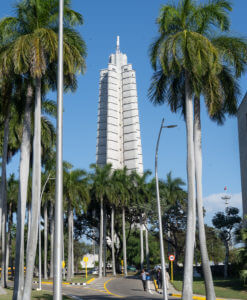 I saw what looked like the only decent shot, pulled out my smaller camera, and took one shot. Immediately the prior guard yelled at me, “Ay!!!” I pretended to not hear and briskly continued my circuitous path, not sure if or when a patrol car would pull up to me and I would be again interrogated for such an innocuous action.
I saw what looked like the only decent shot, pulled out my smaller camera, and took one shot. Immediately the prior guard yelled at me, “Ay!!!” I pretended to not hear and briskly continued my circuitous path, not sure if or when a patrol car would pull up to me and I would be again interrogated for such an innocuous action.
Thankfully nothing further ensued, and I determined to get my revenge for having to waste such effort and walk more than a kilometer in the heat of the day: I would return to the front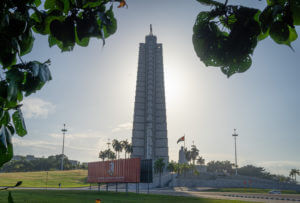 of the tower and take a silhouette photo as the sun lowered. I would show the ugliness of the tower, which looks like something used in north India and Bangladesh, where human bodies are deposited for vultures to consume (burial or cremation is not customary for some religions.) Indeed, at that time there were many buzzards circling the Plaza tower, which heightened the comparison. The whole experience that afternoon angered me, and I was offended by the stupidity of each of my interactions with the government. As an artist, my freedom of expression has always been paramount.
of the tower and take a silhouette photo as the sun lowered. I would show the ugliness of the tower, which looks like something used in north India and Bangladesh, where human bodies are deposited for vultures to consume (burial or cremation is not customary for some religions.) Indeed, at that time there were many buzzards circling the Plaza tower, which heightened the comparison. The whole experience that afternoon angered me, and I was offended by the stupidity of each of my interactions with the government. As an artist, my freedom of expression has always been paramount.
That evening, as I began my walk to the wi-fi signal location some 12 blocks away, I passed a small bodega on the corner and did a double-take when I spied on the counter a large bowl of apples. Apples! My eyes must have bugged out when I came closer to the bowl, for I had not seen apples for sale anywhere in Cuba, and totally craved them. I inquired to the young clerk how they got there, he replied that a box of apples imported from Chile were offered to the store manager when picking up a large order of Cuban rum from a warehouse. I quickly bought six – cost for each was 60 pesos – and stuffed them in one of my carry bags. When I returned to my casa later that evening, I excitedly alerted the women of my find, “¡Manzanas! ¡Hay manzanas en la bodega!”

0 Comments